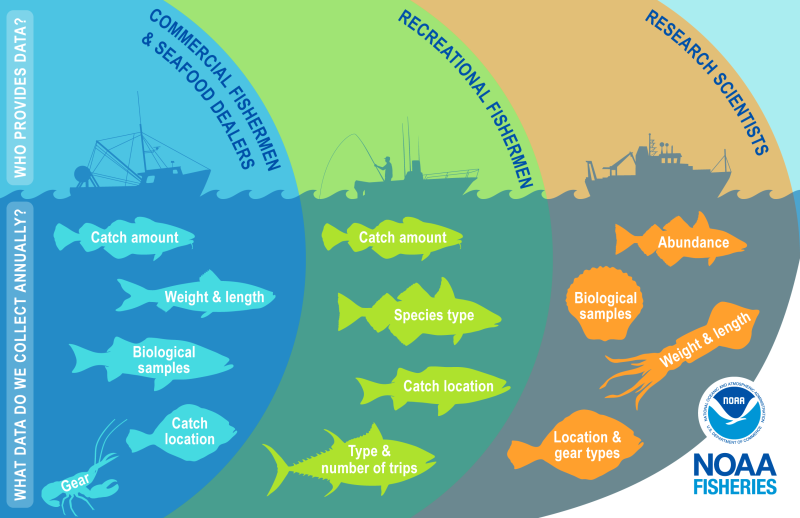Why We Conduct Assessments
We study the size and age composition of fish populations off New England and the Mid-Atlantic, focusing on federally managed fishery species. We do this in order to:
- Monitor the abundance of fish stocks
- Measure the impact of fishing activity
- Evaluate biological aspects of the ecosystem
Together, each element describes stock health through a stock assessment. In our study area, New England/Mid-Atlantic, we assess approximately 40 different fish and invertebrate species, and contribute to marine mammal assessments.
Stock Assessments Use Data From All Sources
Commercial fishermen and fish dealers, recreational fishermen, and research scientists all collect and contribute to fisheries data. Together, these data help us develop our stock assessments, which in turn help us determine sustainable harvest levels for each fish stock.
We use several types of assessment approaches to adequately capture what is happening in a population, ranging from simple to complex. We use simple methods for species for which data are scarce, that have low catch rates or a small population size. We use more complex methods for stocks that are intensely harvested and for which data are more plentiful.
Simple assessment models rely on research survey data and sometimes commercial catch data when available. The resulting assessments typically provide a relative measure of a population’s size and information on whether the population is increasing or decreasing. For more complex assessments we use mathematical and statistical models that depend heavily on data collected by and from commercial and recreational fishing operations. This is especially important for species that have more than one stock within the total population.
The resulting assessments provide detailed information that links fish size and age, reproductive success, and total population. These assessments can also show what catch will be in balance with the stock’s ability to reproduce and replace that catch in the following years.
Getting the Best Possible Advice to Fishery Managers
We use a rigorous process (pdf, 21pg) to develop the multiple types of assessments. Each gets ample expert review before the results are presented to fishery managers. Most of that information is developed through management track assessments. These are routine, scheduled, and provide updated advice to directly inform management actions. They support the New England and Mid-Atlantic Fishery Management Councils and the Atlantic States Marine Fisheries Commission. The Catch Accounting and Monitoring System (pdf, 1pg) allows managers to use the same data to monitor quotas as in our stock assessments.
We also plan twice-yearly research track assessments. These complex scientific efforts can:
- Focus on research topics or on one or more individual stocks
- Evaluate an issue or new model that could apply to many stocks
- Consider extensive changes in data, model, or stock structure
Research track assessments can provide the basis for future management track assessments.
Our assessment staff regularly contribute their scientific expertise to assessments beyond the jurisdiction of U.S. waters. Our international collaborations in both the Northwest and Northeast Atlantic Ocean are an important part of ensuring the overall health of shared stocks.
Additional Resources
- Mid-Atlantic Managed Species (pdf. 1pg)
- New England Managed Species (pdf, 1pg)
- Fisheries of the Northeast
- Research Track Explained
- Management Track Explained
- Northeast Region Coordinating Council Assessment Process (PDF, 21 pp)
- Population Dynamics in the Northeast




